Todd Bartel is a renowned collagist and conceptual artist, and Nance Van Winckel is a friend and colleague of mine at Vermont College of Fine Arts, a poet, fiction writer and a creator of her own Off-the-Page works called photoems; the two of them combine here in a kind of extravagant show-and-tell operation, part-exhibit and part-interview. Bartel’s work, as you can readily see, is a gorgeous and complex amalgam of old books (in the first instance, Hawthorne’s The Scarlet Letter), old paintings, old photographs and frames, quoted, snipped, and translated, objects and their meanings separated and then reworked, colliding in a metaphoric phantasmagoria which creates yet more meanings and also manipulates the perspective/identity of the viewer/reader.
This is the first in what we hope will be a series of such interviews curated and conducted by Nance.
dg
Nance Van Winckel: I appreciate in Garden Study (“A”merican Sublime: Pioneers of New Eden) how the Hawthorne text itself invites the viewer to be a reader, to lean in and to take in the words themselves. Could you discuss your own ideas about this viewing/reading interplay? How does it happen? What makes it happen?
Garden Study (“A”merican Sublime: Pioneers of New Eden), 2004
Two diptych puzzle-piece collages using 19th century paper and The Scarlet Letter remnants (Nathanial Hawthorne 2nd Edition, Riverside Press Cambridge MA 1978, Illustrated), with 20th Century matte and glossy paper, Filmoplast P90, pencil and lead letter type transfer. Arthur Dimmesdale’s collage (left side of frame) is translated from Ralph Albert Blakelock’s painting entitled The Spirit of Night, 1989. Hester Prynne’s collage (right side of frame) is translated from Fredrick Edwin Church’s painting entitled Twilight Short Arbiter, Twixt Day and Night, 1850. Mustard seeds, glass, etched glass, copper tape with patina, 19th century stereoview postcard (View of Salem and Vicinity), archival matt, in handmade (“bent”) frame that turns 90º in order to reside in both sides of a room corner. Each half of the bent frame measures 20 5/8” x 23 1/4” x 1 5/8”. Photo credit: Todd Bartel
Todd Bartel: In 2004, when I was invited by Lucinda Bliss—a direct descendant of Hawthorne and a strong artist herself—to create a work about The Scarlet Letter for inclusion in an exhibition that celebrated the bicentennial of his birth by focusing on his seminal, early American novel, I jumped at the chance to re-read it and to respond with a creation of my own. I started the book not knowing what I would make, and because I am a slow reader, I was glad for the six month lead time before the exhibition. I had no real idea other than I wanted to make a collage out of white paper, and I wanted to somehow involve an image of a landscape. I read the book in high school and enjoyed it, but I was just not prepared for the depth and the beauty of the book I found as an adult reader. My teacher at that time instructed us to skip the reading of The Custom House because it was not in the first edition. So this time around, I was curious to read it. I read it twice before I started the novel proper. During my first reading, I became interested that Hawthorne foreshadowed the portraits of his two primary characters, Arthur Dimmesdale and Hester Prynne, through symbolic descriptions of light and dark, which pervade the text he inserted to his second edition. Despite the fact that neither of their names appear, they are nevertheless thoroughly invoked. As I reread The Custom House the second time around, I took copious quotes in a notebook I dedicate to the project. Once I had collected the quotes, I naturally read the rest of the book looking for connective clues, and I found an abundance. (I must not have been a very attentive high school reader, or perhaps my high school teacher did not appreciate well enough to point out one overwhelming observation I made as a return reader: Hawthorne’s novel is not a typical novel, but is actually a thoroughly haunting, detailed series of character descriptions, punctuated by a handful of key events.) I was astonished to realize that it is his readers who create the plot. And so, my quotes about each of his four characters ended up almost filling an entire notebook! (I also took notes on Hester’s husband, the doctor, and on Pearl, her illegitimate daughter, but those notes will inform a sister project that has yet to be realized.) In fact, as I was creating “A”merican Sublime: Pioneers of New Eden, it would take me an hour or more just to read my own notes on a single character! So deep and so rich are Hawthorne’s observations and descriptions of the human psyche, I decided to create an untypical and odd sort of collage that juxtaposed actual second edition cuttings of his text: key observations about night, darkness, and Dimmesdale with those of day, light, and Prynne. I bought two second editions, one to have and one to cut up. Normally, I juxtapose images as a collagist, but in this case, what is primarily juxtaposed are Hawthorne’s illustrations.
.
.
.
.
(A note about the term “illustration”: A few years ago I learned that “illustration” originally meant verbal descriptions and “exemplifications.” It wasn’t until 1769, when James Granger added blank pages at the back of his History of England volumes for his readers to supplement the text with “extra illustrations” or “cuttings”—pasted book engravings from other volumes or sources—that the term illustration evolved to mean visual information. See Extending the Book—The Art of Extra-Illustration. Granger had unwittingly invented the scrapbook! And since Granger, the sense of illustration being a visual term has eclipsed the original meaning as a literary term. Did Hawthorne know this, and to some measure was he responding to Granger by devoting his entire novel to illustrations of his main characters?)
Selecting certain passages of Hawthorne’s text to juxtapose was like trying to edit Shakespeare! What do you take out? Ultimately, I had to choose quotes that could all live together while pointing to either one character or the other, but which would sadly, not be exhaustive—snippets that together formed an odd sort of paragraph, in the order it originally appeared, with a lot of editing between, but somehow, nevertheless, became page-like in order to illuminate attributes of the each individual’s essence while still referencing the book itself. It was the size and shape of the assembled quotes that altogether determined the dimensions of the shaped frame.
The idea of the shaped frame configuration—which I call a Synterial—came while reading the book, about midway through. Originally, I had set out to make a collage, not a Synterial. However, as it began to occur to me that Arthur and Hester did not live parallel lives—they only ever shared the same space a handful of times throughout the book—the idea of a flat collage was not enough. It seemed to me that their meetings were always events that were far and few between—they met at crossroads, at intersections, at right angles—and understanding that required an altogether different framework. When I realized this, the scope of my initial project expanded and I saw how I could create a shaped frame for the project. Hawthorne’s text had evoked an idea for a frame that could act as a kind of extra illustration of his work. Upon imagining this, it seemed essential for me to create a bent or “cornered frame” to symbolize the choices made by the two main characters. Another way to say this is that I decided to create a frame to house duel portraits by constructing a frame to straddle an actual room corner, which allows for placing one portrait on the left wall and the other on the right. Despite the separateness, both sides of the frame are inextricably bound. Thus, the cornered frame becomes a physical metaphor for Hester’s and Arthur’s choices to back themselves into a place, with nowhere else to move but away from each other.
In addition to collecting and fusing the textual cuttings, I also selected two quintessential pairs of quotes that exemplified each character, and I used them in different ways. I used one set of quotes to impress into the white paper collages of period landscape paintings by Ralph Albert Blakelock (Dimmsdale’s side) and Frederic Edwin Church (Prynne’s side), which flank each text collage. Both painters were alive during Hawthorne’s lifetime, but Blakelock’s painting was created well after the book’s success. Nevertheless, each collage of the selected landscape paintings—which I refer to as white paper translations or blank paper translations—echo the character adjacent to the text collage. Blakelock’s, The Spirit of Night, 1886–95, bears the phrase “joy unutterable,” and Church’s, Twilight, Short Arbiter ‘Twixt Day and Night, 1850, bears the phrase “beneath the open sky.”

Text impressed into white paper collages using 19th century lead type, rubbed, bone burnished from the back of each respective collage
Dimmesdale refused to publicly share his secret while Prynne wore hers out in the open. Similarly, Church was widely known for his plein-air paintings, while Blakelock’s fame came from his paintings of the night sky, and although sadly appropriate, Blakelock went “mad” by the end of his life, which seemed compelling enough to reference for a portrait of Dimmesdale. The second pair of quotes was etched into the glass and reside over the respective text collages. Each was taken from that moment in the book when late in life they met in the forest and asked each other the following questions:
Dimmesdale: Dost thou yet live?
Prynne: Art thou in life?
Those questions exist as if to say, “Was it worth it?” For me, this attitude of American passion seemed a defining characteristic of our culture. As one of the first widely published American novels, it seemed not a stretch of the imagination to claim this couple as America’s very own Adam and Eve.
NVW: I think the boxes themselves give these pieces such power and resonance. The encapsulated. The crypt-like. The one lifted out of the many. I’m intrigued too with your ideas about “Stynterials” and “coupling particular frames with particular verbal ideas.” Might you say a little about what’s inclined you to the “boxed”?
TB: In a wonderful essay on the boxed sculpture format, Donald Kuspit wrote, “Inner reality will always find a way to act itself out through external reality. This process is what the box sculpture epitomizes.”1 Kuspit’s observation is what allowed me to stay making boxed constructions when I was in graduate school and was heavily questioned about why I put my work in frames, behind glass. Cornell had epitomized the process and many others had come before me. Such history made it hard for me to find the wherewithal to attempt to contribute to the genre. But it was Kuspit who helped me to realize that whatever I put inside the box would equivocate my existence and my experience, something that is not reproducible. I began the Synterial series when I realized that the box does not need to be square. The first Synterial idea I developed was the notion of a frame with a bridge to another frame—an idea that stayed dormant until the day I took my five-year-old son to the Planetarium in NYC the early winter of 2001. At that marvelous museum in the first vitrine, which has a beautiful display of the elements from the periodic table, I found a quote from Walt Whitman alongside the rocks it contained: “I believe a leaf of grass is no less than the journey work of stars.” In that instance I saw the rationale for what it meant to create a frame with a bridge to another frame. Soon afterward I realized that all the other ideas I had for shaped frames needed to be informed by accompanying texts.
Todd Bartel, Garden Study (Pollination of Devonia), 2002, 55 3/8” x 22 5/8” x 1 1/4”
Computer-cut mat board, etched glass bearing the word “re member,” mustard seeds between three layers of glass and copper tape with patina in constructed wood frame; watercolor, ink, Craypas, tempera, charcoal, and blood on two pages from Ovid’s Metamorphosis, with collage on 19th century engraving; tempera and watercolor over Xerox transfers (text from Genesis 1–3, 26) on 19th century book end pages. Photo credit: Tom Young

Elements of human biology and watercolor interpretation of Charles R. Knight’s rendition of the Devonian Era
NVW: Joseph Cornell. I know you were just part of a show of visual artists following in the Cornell tradition. So many poets have written poems to him or for him. Charles Simic has a whole book of prose poems devoted to his work (Dime Store Alchemy). What is it about Cornell’s work that you think speaks especially to readers and writers? And do you think that same “something” pertains to your own work, and if so, how and/or why?
TB: Cornell once wrote on a scrap of paper, “Nostalgia anyone?”
Cornell’s invocation says so much about his work, my own work, and I think collage in general. The past is rich beyond adequate expressiveness; to rekindle it is to offer another chance to see again. As a collage-based artist, I am always compelled to pull the past back into the present as a way of pointing out we are not done thinking about the thing that reappears. My current work is about landscape and cultural identity. Cornell’s work was always about the subject of wonder. I share an affinity for that aspect of Cornell’s universe, and often my study brings me to the same materials he used, particularly those of the nineteenth century. But my acute fascination surrounds the transition from the industrial age into the one we find ourselves in now and that is where my work separates from the twentieth century master’s.
1 Kuspit, Donald, On Being Boxed In, in Sculpture, Vol.10 # 4 , November–December 1991, p. 37.
— Todd Bartel & Nance Van Winckel
—————————-
Nance Van Winckel will have two new books out in 2013. Pacific Walkers, her sixth collection of poems, is due out from U. of Washington Press, and Boneland, her fourth book of linked stories, will appear with U. of Oklahoma Press. She is the recipient of two NEA Poetry Fellowships, an Isherwood Fiction Fellowship and awards from the Poetry Society of America, Poetry, and Prairie Schooner. New poems appear in The Pushcart Prize Anthology, The Southern Review, Poetry Northwest, Crazyhorse, Field, and Gettysburg Review. She has new short fiction in AGNI, The Massachusetts Review, and Kenyon Review. She teaches in the MFA in Writing Program at Vermont College of Fine Arts.
Her primary interest lately is Poetry-Off-the-Page, and she has had work in several juried art shows of her “pho-toems” (photo-collage with text). A solo show of this work opened in January at the Robert Graves Gallery in Wenatchee, Washington; examples may be viewed at: http://photoemsbynancevanwinckel.zenfolio.com/.
————-

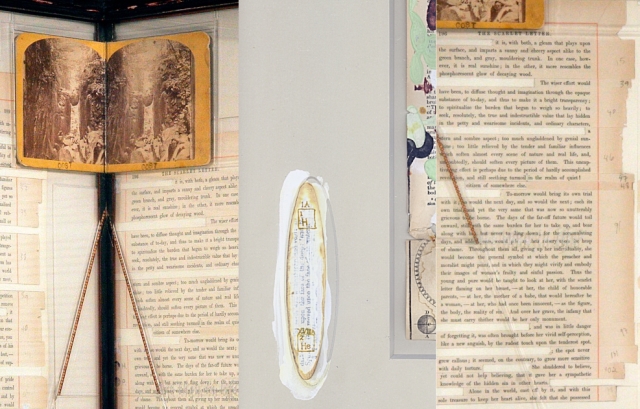
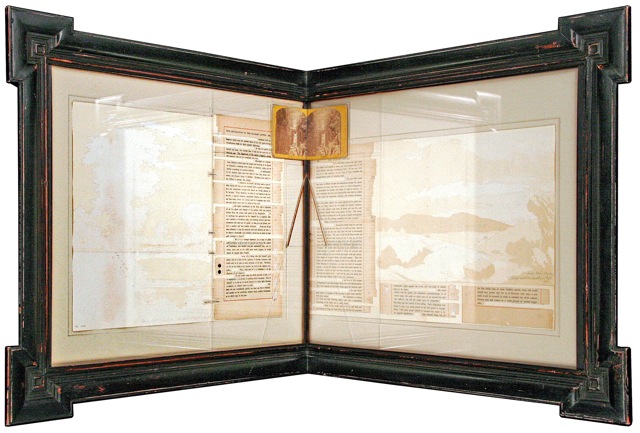
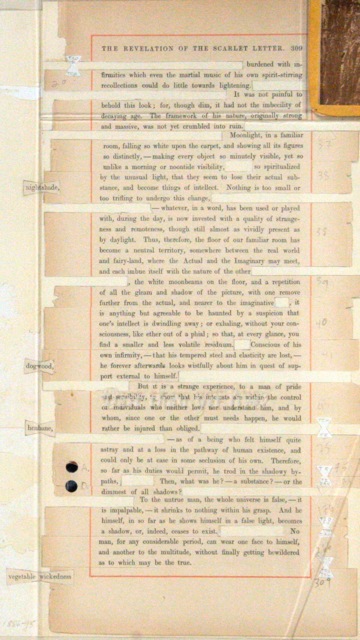
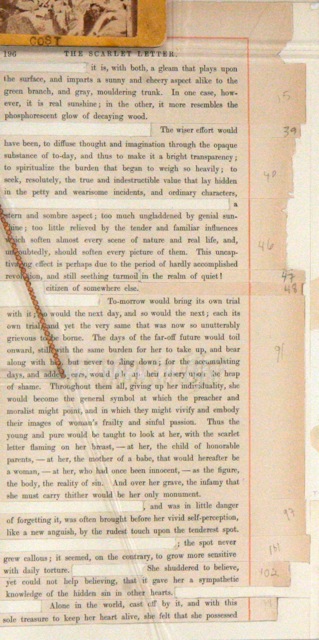



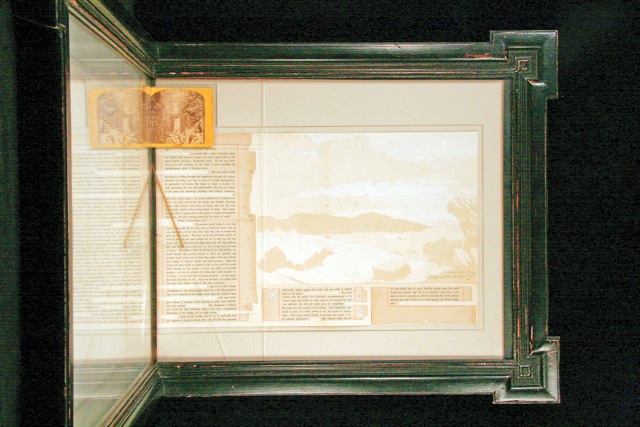
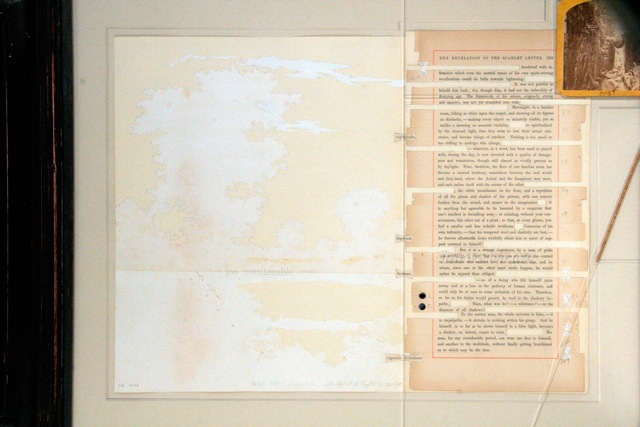


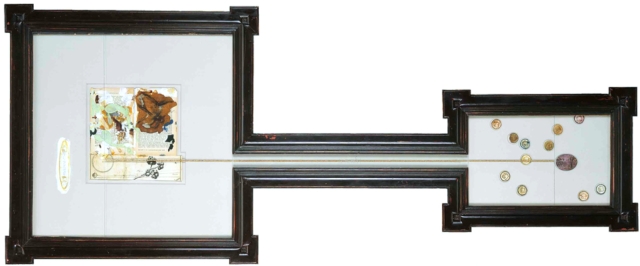
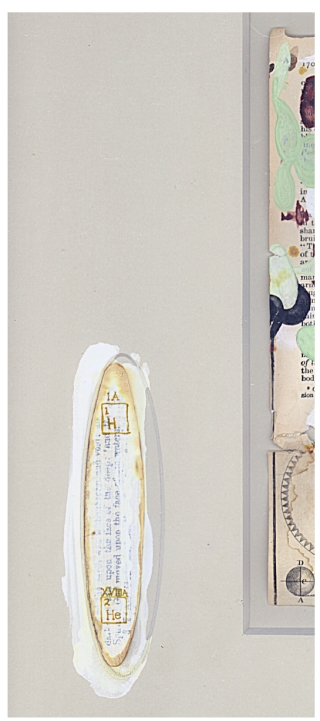
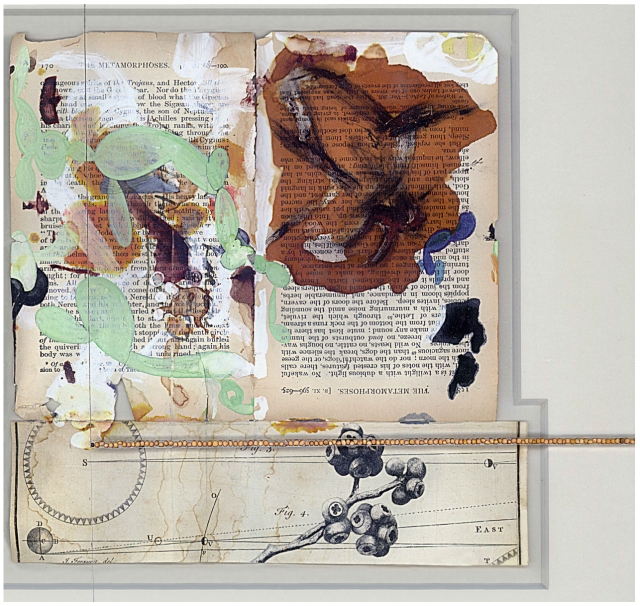


If someone encounters one of your text-referenced collages cold, having last read Hawthorne in junior high if at all, what meaning will it have for them? Does it matter what they know of your intentions?
Thanks for the great question China.
On one hand, artists can only have so much control over their work because viewers come from countless backgrounds and undoubtedly have had countless experiences that inform how they might read a particular work. So my guessing what meaning a viewer will have, having read or not read The Scarlet Letter is certainly difficult to speculate upon. On the other hand, artists are in control of what they include in any given work and that certainly helps to limit potential meaning/s. I love your question because it gives me an opportunity to share just a bit about my selection process, regarding what I generally tend to include in my work and why.
Because I am all too keenly aware that people, myself included, bring whatever they experience with them when looking at art, or experiencing any creative expression for that matter, I tend to select things that have several meanings, that can become springs boards for more than one lineage of thought, association or feeling. Despite the specificity that Hawthorn’s readers can more easily recognize regarding my specific references in “A”merican Sublime: Pioneers of New Eden, the provided elements, images and objects altogether also point toward general topics which are, I think, accessible to many viewers. I spend a lot of time looking for things before I ever set out to make something. I search for objects/images that have specific meaning for me on the one hand and general references to larger topics on the other hand. I look for things that can spark double meanings. That way, I am assured of at least a couple of readings I intend, while also allowing for others, I cannot yet imagine. For example, someone once asked me if I intended to “make the “A”merican Sublime frame in the shape of an open book” and I marveled at their good connection, which I did not have when I set out to make the work, and, I thanked them for the new thought. As far as I was concerned that was a great entry point for that viewer.
Collage taught me that one plus one equals three; or, put in another way, one object plus another object equals a third thing. A case in point is Varujian Boghosian’s assemblage in which he placed a small rock on a dollhouse chair—a rock on a chair, rock, chair—rocking chair. Two juxtaposed things become a third thing when contemplated together. And so, just by collecting things and juxtaposing them, one cannot help but to find connections. Although viewers may choose or ignore opportunities to find meaning, meaning is there, like a seed, ready to take root. This is true, for anyone, because we share a common language. As such, I hope to prompt guided associations; but I also acquiesce to the possibility of multiple readings beyond what I am aware of at the time of making. When it comes to what I put into my work, if it does not allow me to think in more than one way, then I generally do not choose to work with it.
To answer your question directly, I would guess that viewers would probably notice at a distance the images of the landscapes, the text cuttings and the shape of the frame well before ever discovering the title and the materials citation, which lists the American painters, and the titles of their paintings I appropriated, as well as Hawthorn’s book and characters. Having those things in mind as viewers approach the piece would certainly be helpful to how they would read the work. But even having not read The Scarlet Letter, I suspect that just about anyone looking at the collected descriptions of darkness and lightness would have all sorts of associations and connotations come up as they read the descrptions. Darkness is sometimes associated with evil and sometimes associated with lack of insight, whereas, lightness is sometimes associated with goodness and sometimes associated with enlightenment among many other things. At the very least, if someone looks at “A”merican Sublime: Pioneers of New Eden and begins to wonder about those things alone, I would already think that as far as my intension goes, I have been successful in that general thought process about my work that looks at light and dark. If while thinking about dark and light and the fact that the words “America” and “Eden” appear in the title, I suspect that can too can lead to other kinds of thoughts, and for me, that possibility starts to get really interesting because there is no one right or wrong view. Some people view inhabiting new Eden and expelling others was a good thing, while others think that was a bad thing. It’s both and that is problematic. I created the work to point at such issues—the bent frames allows for each side to reflect each other and that makes it difficult to see clearly. I hope my work raises more questions than it answers. And that, actually, is closer to what I hope happens for my viewers: raising and asking questions. As an artist, I learned to let go of my desire for controlling a viewer’s thoughts a long time ago and I turned my attention toward prompting questions instead. My hope is to make multi-layered work that unfolds in time. I try to make unfoldingobjects.
After having read the interview with Nance Van Winckel in Numero Cinq, I gained a better understanding of your magisterial work, “Garden Study.” Among other things, I was unaware that Hawthorne’s novel, “The Scarlet Letter,” was atypical (for the period) in that it allowed, enabled or encouraged readers to make their own plots! The notion of “interactive art” in terms of making works is a relatively recent development and therefore astonishing to find such an early precedent. This, and Hawthorne’s prescience regarding the evolving concept of “illustration,” puts the author of one of the first American novels at least two centuries ahead of his time!
I am intrigued by the term, “synterial.” Presumably this is a neologism, so how exactly do you define this term? Does the word refer to more than merely a shaped frame that somehow adds or imparts meaning in relation to the content of the material that it houses? I could relate, of course, to Kuspit’s remark about “inner reality acting itself out through external reality” through, as he put it, “boxed sculpture.” Boxes and frames are, as you know, related and raise equally fascinating questions about the relation between internal and external reality.
Paul
I appreciate your question and all your comments Paul. Thank you for posting them.
I don’t know what others will make of my summation of Hawthorne’s text, but from my own observations, I felt justified to make those claims. I would roughly estimate that Hawthorn described his characters for 98% of “The Scarlet Letter.” There was very little story line in the traditional sense.
Regarding your question about my coining the term “synterial,” yes, your comments are one important aspect in that the frame shape points toward content, but, that by itself is not the main reason why I conjured the word. In each instance, making the four shaped frame pieces—btw, my fifth synterial is on the way—I had to completely develop every aspect of the work simultaneously. For example, lets take the first project in the series, the frame with a bridge to another frame. Initially I wanted to decide upon the dimensions, but nothing yet existed to frame in the first place, which is when I realized everything had to materialize simultaneously: both frames, the bridge, the drawings, the paintings, the glass sandwiches with mustard seeds between, the oddly cut matt boards, the collages, the collected and altered texts, and the sandblasted glass all needed to be understood in terms of their practical dimensionality.
Sol LeWitt said, “The idea becomes the machine that makes the art.” But I had to have not one, but many ideas before I could make these works. What shapes are the frames and why? What shapes are each component and why? Thus, despite having had concrete ideas for each frame, I had to generate all the interior materials before I could ever construct the exterior containers. Yes, this is a basic need for artists; make the art, then take it to the framer or make the frame. But, to make a multifaceted frame with unique interior components, the whole piece had to also be imagined despite the nonexistence of the parts. I had to conjure everything simultaneously, when I had no tangible idea what it would actually all look like.
Another way of saying this is that I am used to working with found materials, and so I had to first generate all my own objects and images, to in affect, synthesize them so I could consider them found. This forced seeing them all in my mind’s eye well enough that I could commit to making certain things and consequently develop each component alongside the other. Wonderfully, It was as if I had to create a bunch of readymades so I could then collect the parts prior to assembly and that is why I eventually I likened the process to that of a film director’s or an architect’s. I needed to work with the wood worker, the abstract expressionist painter, the librarian collecting texts, the collage artist, the glass cutter, the wood worker, and the list goes on; and, all those jobs were mine alone.
It is funny how simple it is to say the synterial frame ideas:
a frame with a bridge to another frame
a cornered frame
a pregnant frame
a spired frame
But, these synterials are by far the most complex projects I have ever created. Some of them required cutting over fifty pieces of wood to assemble the frames alone. Calling the work a collage or an assemblage just did not seem enough—did not seem an accurate division of labor. “Synterial” seemed to better emphasize the synthetic aspects of grouped processes. Indeed, the “interesting” thing about Kuspit’s quote in this context is that his sentiment is almost inverted. Literally, the external reality of the synterial points to internal reality of what it contains.
Paul Forte and China Marks are artists of great reputation. Readers are encourage to check out their respective works at:
pauljforte.com
chinamarks.net
Todd,
Thanks for bringing these people into the NC firmament. I like the way that, with NC, one thing always leads to another. I have already been in touch with China.
dg
I loved your reply to paul forte about synterials! Thank you, Todd for your wonderful contributions to NC., Nance
Thank you Nance. It was such a pleasure to work with you and to explore my work on Numéro Cinq. I am most grateful for this opportunity.